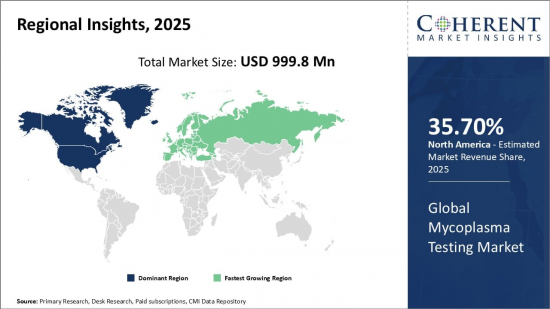Global Mycoplasma Testing Market is estimated to be valued at USD 999.8 Mn in 2025 and is expected to reach USD 1,935.9 Mn by 2032, growing at a compound annual growth rate (CAGR) of 9.9% from 2025 to 2032.
| Report Coverage |
Report Details |
| Base Year: |
2024 |
Market Size in 2025: |
USD 999.8 Mn |
| Historical Data for: |
2020 To 2024 |
Forecast Period: |
2025 To 2032 |
| Forecast Period 2025 to 2032 CAGR: |
9.90% |
2032 Value Projection: |
USD 1,935.9 Mn |
Figure. Global Mycoplasma Testing Market Share (%), By Region 2025

Mycoplasma testing is essential in the field of biotechnology and pharmaceuticals. There are different types of products available in the market for mycoplasma testing. The major products can be categorized into two types - kits and services.
Kits are self-contained tools that allow researchers to test for mycoplasma contamination on their own. These kits have all the necessary reagents and instructions to perform the test. The most common types of kits are polymerase chain reaction (PCR)-based kits, enzyme-linked immunosorbent assay (ELISA) based kits, and microbiological-based kits. PCR kits are highly sensitive and specific but require specialized equipment. ELISA kits are easier to use as they don't need specialized equipment but are less sensitive than PCR. Microbiological kits involve detecting mycoplasma growth directly but take longer time to give results.
Along with kits, various companies offer mycoplasma testing as services where researchers can send their samples to specialized testing facilities. The advantage of services is that researchers do not need to invest in equipment or training. Experienced technicians at the service facilities perform different types of tests like PCR, ELISA, and microbiological assays and provide reports. However, there can be delays in getting results as samples need to be shipped. Kits allow for faster testing but require proper infrastructure. Both products have their advantages in different situations depending on individual lab requirements and capacities.
Market Dynamics:
Growing research and development (R&D) activities by the market players is expected drive the market growth over the forecast period. Moreover, increasing organic and inorganic strategies by the market players will aid in the market growth over the forecast period.
Key Features of the Study:
- This report provides an in-depth analysis of the global mycoplasma testing market, and provides market size (US$ Mn) and compound annual growth rate (CAGR %) for the forecast period (2025-2032), considering 2024 as the base year
- It elucidates potential revenue growth opportunities across different segments and explains attractive investment proposition matrices for this market
- This study also provides key insights about market drivers, restraints, opportunities, new product launches or approval, market trends, regional outlook, and competitive strategies adopted by key players
- It profiles key players in the global mycoplasma testing market based on the following parameters - company highlights, products portfolio, key highlights, financial performance, and strategies
- Key companies covered as a part of this study include Charles River Laboratories International, Merck KGaA, Lonza Group Ltd, Roche Diagnostics, Thermo Fisher Scientific, Merck, InvivoGen, Creative Bioarray, and Other Prominent Players
- Insights from this report would allow marketers and the management authorities of the companies to make informed decisions regarding their future product launches, type up-gradation, market expansion, and marketing tactics
- Global mycoplasma testing market report caters to various stakeholders in this industry including investors, suppliers, product manufacturers, distributors, new entrants, and financial analysts
- Stakeholders would have ease in decision-making through various strategy matrices used in analyzing the global mycoplasma testing market
Detailed Segmentation:
- Global Mycoplasma Testing Market, By Product Type
- Kits & Reagents
- Instruments
- Global Mycoplasma Testing Market, By Application
- Cell Line Testing
- Virus Testing
- End of Production Testing
- Others (Raw Material Testing, etc.)
- Global Mycoplasma Testing Market, By End User
- Pharmaceutical & Biotechnology Companies
- Contract Research Organizations
- Academic Research Institutes
- Global Mycoplasma Testing Market, By Region
- North America
- Europe
- Asia Pacific
- Latin America
- Middle East
- Africa
- Company Profiles
- Charles River Laboratories International.
- Merck KGaA
- Lonza Group Ltd
- Roche Diagnostics
- Thermo Fisher Scientific
- Merck
- InvivoGen
- Creative Bioarray
- Other Prominent Players






